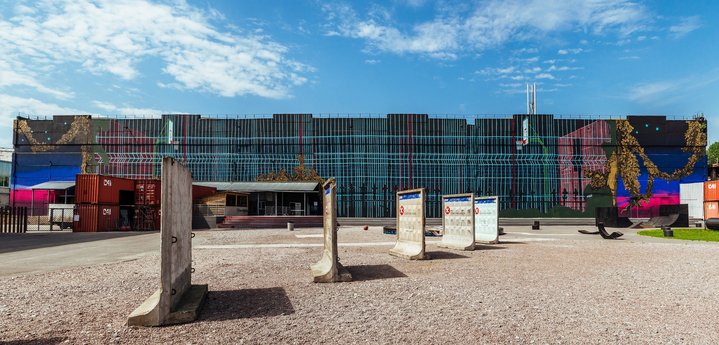A reinvention surrounded by plastic

A view of "Rooted to the spot" at the Street Art Museum, 2019
A factory of ideas in an industrial zone on the eastern outskirts of Russia’s former capital where street artists are invited to create among the relics of Soviet industry
In Russia’s old imperial capital, the most imaginative, provocative and colourful new art is to be found in the grounds of a laminated plastics factory with the unlikely name of SLOPLAST. Thanks to the factory’s owner, Dmitry Zaitsev, it opens the doors of St. Petersburg's increasingly popular Museum of Street Art to the general public from May to September every year for summer exhibitions. Visitors are allowed during the rest of the year, but must apply for a pass to gain entry.
The project was unveiled in 2014, the year when Manifesta, the European Art Biennale, was held in St. Petersburg. It coincided with start of the war in Ukraine that summer. 30 Russian and 27 Ukrainian artists took part in that Russian Manifesta, something that would be difficult to conceive of nowadays.
The industrial site was originally in ruins but was restored by the Finnish architectural firm JKMM, and the plastics factory continues to work all year round. The restoration was done using inexpensive but eye-catching methods, employing such approaches as gravel for fill-in material. Side walls were created using metal barrels and semi-translucent fences were assembled from thick pipes. The site acquired a clear structure, boundaries, walls, and modules, allowing the entire space to be perceived as a kind of "gallery" which could now be used for exhibitions.
Industrial sites suggest grim and barren buildings, but it is precisely the way that street artists have decorated this one that turns it into a playground of irony under the watchful eye of that popular symbol of Soviet power, a statue of Vladimir Lenin. The space is both grandiose and dramatic and the colours on the walls are bold, turning the space into a playground for curious adults under the watchful eyes of children.
Even before the museum’s 2014 official inauguration, top international and Russian street artists were invited to create works on the factory’s walls.Among the artists who made their mark on that unusual museum were Spanish street art star ESCIF, Ekaterinburg’s Timofey Radya, known for his deep and poignant messages, and Moscow’s Kirill Kto, whose hallmarks are multi-coloured lettering and paradoxical wit.
The giant face of “Alyonka,” copied from the wrapping of a favourite Soviet childrens’ chocolate bar, was painted on a concrete slab by an artist who called himself Pasha183 (1983-2013). Banksy was among those who highly appreciated his talent. The work was brought all the way from Moscow after the street artist’s death and it is now part of the museum’s permanent collection.
During the second show in 2015, the St.Petersburg artist and set designer Alexander Shishkin-Hokusai created an impressive installation “The coming-of-age rituals,” comprising 200 life-sized cardboard figures. Hugely popular, it has since traveled to various Russian cities. This year, that artist created an installation for the Russian pavilion at the Venice Biennale, as well as one for the theatre-related Prague Quadrennial. Both artworks were made on the premises of the St. Petersburg Street Art Museum.
The institution often invites international curators to put its summer shows together. The 2016 project was dedicated to migration issues, and was curated by British anthropologist and urban art scholar Rafail Schacter. Yasha Young, director of Berlin’s Urban Nation Museum for Urban Contemporary Art, curated the museum’s 2017 show.
The curator of the 2019 exhibition is St. Petersburg street artist Maksim Ima, who chose the title “Rooted to the spot.” The exhibition project is meant to be a direct response to the most frequently asked question: ”What is street art?” This year, the space’s main 15-metre wall was given not to a street artist, but to a well-known St. Petersburg painter, Vitaly Pushnitsky.
The subject of his painting is the opening line of Dante’s Divine Comedy: “Nel mezzo del cammindi nostra vita mi ritrovai per una selva oscura" — "In the middle of the journey of our life, I came to myself, in a dark wood." In this, the “dark wood” is a mirror of contemporary Russia. The centre of the composition is an empty sports area squeezed between the walls of a megalopolis. As is fitting, the sports area has a mesh fence. In the final version, the energetic bright lines of the fence’s diverse meshes completely block the initial image. But what transpires is the battle over a project to build a church in a park frequented by the inhabitants of the Russian city of Ekaterinburg. That battle is being fought far away in the Urals, but its echoes are heard throughout Russia.













